Refit of the legendary Devon crabber Excel DH 17
Last but not least in my current review of inshore refits is the famous Devon crabber Excel DH 17.
Built by J Hinks & Son of Appledore in North Devon, construction of the Excel was one of the fastest on record for a vessel of its size. It was launched in 1971 to take part in a lobster boom.
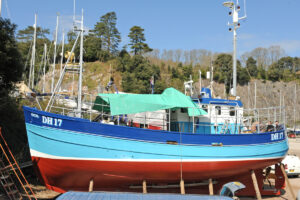
On her relaunch, Excel looked as good as new.
On its build, the Excel measured 16m LOA, but when it joined the South Devon inshore fleet around 15 years ago, a new stem was fitted to reduce its length to 14.95m to remain within local byelaws.
Wooden fishing craft have a remarkable history, and the Excel is no exception.
Although its recent refit – which took place at Dartside Quay Marine Service Centre near Brixham – was mainly an engine and gearbox replacement, considerable metalwork within the engineroom was replaced with stainless steel. And after being spruced up and repainted, the Excel looked ‘as good as new’, and was relaunched a couple of months ago.
Owned by R&L Mitchelmore, a business partnership between Rick Mitchelmore and his wife Lyn, Excel is one of several boats owned by firms that the Mitchelmore family are part of. Skippered by their son Simon, Excel works as a day-boat in a lucrative but closely controlled South Devon fishery.
R&L Mitchelmore bought the Excel in 2004. This was a difficult decision because Excel had worked hard through the previous 34 years, and a major refit was required, but the family firm decided to take it on. By the turn of 2005, the Excel had been shortened and a new Volvo engine and gearbox had been fitted. Other major improvements to the layout of the Excel were also carried out.
In digging out details of the Excel’s history, I spoke to a shipwright who worked on its build – Bobby Cann from Brixham.
He has fond memories of being part of building Excel, and from what he says, it is a good job that the shipwrights were young – the rush to build Excel was made clear to all who took part.
Bobby Cann explained: “Just before Excel’s keel was laid, I stepped off a wooden replica of the famous ketch Nonsuch.
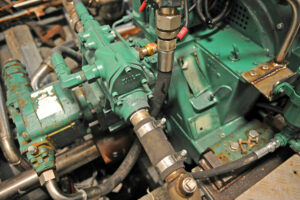
Hydraulics taken direct from the gearbox.
“Built at J Hinks & Son, the Nonsuch replica was made to celebrate the original Nonsuch – built as a merchant ship in 1650, it served well as a 17th-century vessel, but its merchant days ended when it joined the Royal Naval fleet. Nonsuch eventually returned to being a merchant vessel, becoming a legend. Nonsuch sailed across the Atlantic Ocean into Hudson Bay, Canada – the first trading voyage for what was to become the Hudson’s Bay Company. It was a massive voyage for such a small ship.
“I took part in the build of the Nonsuch replica. On completion, I volunteered to sail on that vessel around Europe. It was an important time for me, because together with a business partner, I bought the trawler Les Marseilles from the Brittany port of Guilvinec. In order to help pay for that, I went back to work at J Hinks & Son when the order to build the Excel was about to start.
“It wasn’t long before several other boatbuilders and myself began framing and planking the Excel. It was designed by Gary Mitchell – Gary can’t have been over 25 at that time, and we were all very young. The boatbuilding trade in wood was quickly increasing. Jobs were available at many yards.
“Excel was built for a Paignton firm of which Mr Maurice Browse was one, and because there was a boom in lobster catches off Portsmouth, Maurice Browse wanted Excel built as quickly as possible. Alan Hinks, the head of J Hinks & Son, never let us forget that – we were working 10-hour days for five days a week. On Saturdays, we would work until 1.30pm – then, in less than 30 minutes, we were in the pub, the Beaver! Saturday afternoon and Sunday were the only time off that we had.
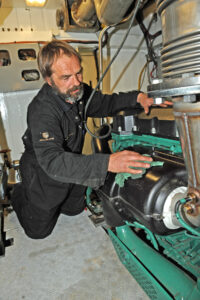
Shane Gibson giving the final touches to the new Volvo Penta D13.
“Excel is built of 2in iroko planking on double 2.5in oak frames. She was built very strong – a very heavy boat, very solid – and the Excel was built on time. Many years later, the boatbuilder Brian Pomeroy shortened her. He told me that he’d never before seen such a strong boat for its size. In my opinion, Excel is one of the best fishing boats ever built at the yard of J Hinks & Son.
“Originally, Excel had a capstan driven mechanically from a Petter engine, about 30hp. The original main engine was a Volvo MD120; Excel has stayed with Volvo engines all through her life. She’s a big and beamy boat, but one with lovely lines.
“Shortly after Excel was completed, a near-identical boat, the KMB, was ordered (the name taken from Ken and Maurice Browse). But it had to be built in Denmark, because J Hinks & Son were so busy that they couldn’t fit that contract in. In my opinion, although the KMB was a nice build, it wasn’t quite the ship that Excel is. Excel was an advanced boat for that day – the first wooden boat I had seen that was fitted with steel engine beds.
“On the Excel’s launch, I heard Maurice Browse say that the Excel was one of the best-looking boats he had ever seen, but he added that it would look even better when it was on its way to Dartmouth! I left J Hinks & Son shortly after the Excel was completed.
“We had all worked so hard to get it completed on time. We were all youngsters – even the foreman who cut all the planks out for us wasn’t that old. We were forever told that the boat must be a credit to the yard – and she was. If the yard were here now, she still would be. Under Rick Mitchelmore, the Excel is well looked-after, and she remains a lovely boat.”
Chief engineer Shane Gibson oversaw, and played a major part in, the recent refit. He has worked for Rick Mitchelmore for 31 years, starting as a crewman on the first new Mitchelmore vessel, the William Henry DH 5.
Shane now oversees all the Mitchelmore vessels, and explained that the present refit was mostly a re-engine and new gearbox job. “The new engine replaces a 15-year-old Volvo Penta TAMD103, one that we installed just after Rick bought the boat. With good maintenance, that engine had served for well over 30,000 hours between each overhaul. However, this time a rebuild would have cost almost as much as a new replacement, so Rick has chosen a new D13, and that’s no surprise – Excel has been driven by a Volvo engine all its life.

All except the silencer of the new 6in-diameter exhaust system was made in-house from stainless steel.
“Soon after Rick bought the boat, we discovered engine problems. The option of fitting a new Volvo was discussed. Fishing was fairly good, and I was given instructions to get a new engine and get it fitted as soon as possible – that was the Volvo TAMD103 that we have just removed.
“But as soon as the fishing slacked off during the winter of 2005, we decided to add to its new engine and give the Excel a serious refit. The wheelhouse was gutted; all that was left was its sides – no roof and no floor – we took away the lot.
“The replacement outer woods were not glassed over; the roof was epoxy-sheathed, and we also fitted a new wheelhouse floor. The accommodation was also ripped out and replaced. It was a major refit.
“So, 15 years on, we’ve installed a new engine. Everyone was saying how good the Volvo Penta D13 is, and so far we can confirm that. It’s a bit early yet to compare the fuel consumption figures to those from the old TAMD103, but we expect the new D13 to make a saving.
“The D13 meets modern specifications, and being electronically controlled removes the need for Morse cables. Also, through a stainless steel system that we made onsite, we have chosen keel cooling for the D13. We have installed a completely new exhaust system, all made of stainless steel; it replaces a 4in-diameter system on the TAMD103. The new exhaust system is 6in in diameter; everything except the silencer is made of stainless steel.
“In addition to the engine replacement, the propeller was serviced and rebalanced at Teignbridge Propellers, and South West Marine Painters have done an excellent job on painting Excel’s hull. On launch, Excel looked brand new. We have changed all of the vessel’s skin fittings from screw-operated bronze to bolt-fitted stainless steel equivalents, made especially for us so that if necessary, a fitting can be unbolted from inside the hull with no fear of it twisting and breaking in the process. Everything is wired up for cathodic protection.”
Although skipper Simon Mitchelmore is now the longest-serving skipper of the Excel, the second-longest was Trevor Bartlett, now owner of a major shellfish processing firm, The Blue Sea Food Company Ltd, based in Paignton.
He told Fishing News: “Until Simon took over Excel, I was its longest-serving skipper. I started working on Excel in 1978, and took over as skipper in September 1981, where I stayed for six years, until together with Reg Matthews of Teignmouth I invested in the Euroclydon, the first true super-crabber in the UK.
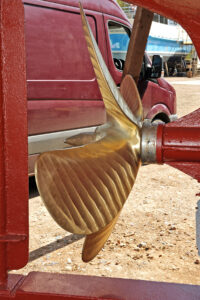
Excel’s prop was rebalanced and refurbished by Teignbridge Propellers, in preparation for now being driven by the new centreline machinery.
“When Excel was launched in 1971, I was just 16, and I remember coming around on the Excel from Appledore to Dartmouth – its maiden voyage.
“Perhaps I’m biased to say so, but the Excel was, and remains, a really lovely boat. The time I spent working on, and later skippering, the Excel – those times bring back happy memories. When I was a crewman, we were working only 360 pots to start with, and we worked them five days a week whenever we could. By the time I left, we were working 800 pots every other day, but if the fishing was good, we would put another day in.
“Towards the end of working on the Excel and having the Euroclydon built, I wanted to develop a system where we could easily detach the pots and move those pots around the boat. I developed the toggle system, using a spinner and threading it through a specific-sized rope loop at the end of the leg, which turned out to be very successful. We still use it now on our vessel Amadeus. I believe many others now use the toggle system, including Excel!
“Excel is a great sea boat, and I took some of my ideas from her to Euroclydon, but that wasn’t a good move – I was going from a relatively small boat to a super-crabber, a boat where everything wasn’t driven off the main engine. We did get the Amadeus right, though!
“I remember that for a few years the Excel went through a period of low maintenance, but since Rick Mitchelmore has owned it, there has been no expense spared, and it’s now in excellent condition, which is a credit to him and his team.”
Rick Mitchelmore explained: “When we bought Excel in 2005, it was in a pretty poor state, but it was fishing on good ground off Start Point, so we completely and quickly refurbished it, fitted a new engine, and that engine has lasted until now, 14 years later. It did have a major overhaul in the middle of that time, but this year it was time to have a new engine – it would have cost so much to have it refurbished that a new engine was almost the same price.
“My son Simon skippers the Excel. Simon has never liked going away on the bigger boats – the super-crabbers – so a day-boat like the Excel is perfect, probably the best day-boat crabber you can get.”
Wooden boats show longevity
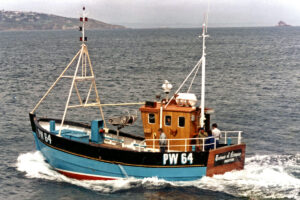
… as probably the last wooden potting boat built for the South West on launch in 1986.
At the turn of this decade, some of the remaining wooden boats in the British fleet might have been very old. However, as with the trees from which they come, the term ‘age’ is a very different concept to the term ‘age’ in a steel boat. If looked after properly, the life of wood is far longer than many will ever imagine. It easily outstrips steel, and although GRP is a contender, were I a betting man, I would choose wood to put my money on for the longest-serving boatbuilding material.
Over my years touring the South West, 30 years ago new wooden boats were literally streaming from wood-building yards like J Hinks & Son, C Toms & Son, John Moor, G Pearn & Son, Cann & Pender (Bobby Cann) and several others. On one of my few visits above the Scottish border, Nobles of Girvan was building Britannia V – in truth a work of art – and I have no doubt that numerous other Scottish yards were of equal standing.
There is something pretty special about a wooden boat. While wood no longer challenges the money-making potential from having a steel boat, the day will come when the price of red diesel soars, when sleek-lined and lower-powered boats, like wooden boats such as the Excel, will be the last to go.
Perhaps there may be new-builds like Excel gracing the pages of Fishing News in the years ahead – even boats with ‘fuel efficiency’ spurred by having some degree of sail power. (I wonder what the MMO would do with its power ratings on licences then!)
I daresay I won’t be here to see it, but I’m 100% certain that it will happen – an alternative to total fuel power must be found.
William Henry DH 5
Also built at J Hinks & Son and launched in 1985 was the wooden vessel William Henry DH 5, Rick and Lyn Mitchelmore’s first step into owning bigger vessels. William Henry was one of the last wooden crabbers of its size to join the South West shellfish fleet.
Being a very successful vessel, the profits from this wooden boat delivered another step up on the ladder for Rick Mitchelmore to move from a day-boat to the nomadic super-crabber William Henry II – on which the registration number DH 5 remained.
The success continued, and the Mitchelmores invested in another super-crabber, Edward Henry DH 100 – but little did Rick and Lyn know that 20 years later, the family would reinvest in a wooden day-boat – one built by J Hinks & Son.
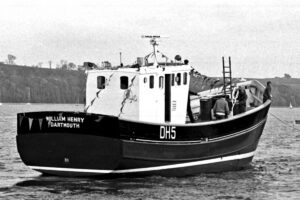
William Henry, probably the last wooden crabber for the South Devon fleet, was built at J Hinks & Son and launched in 1985.








